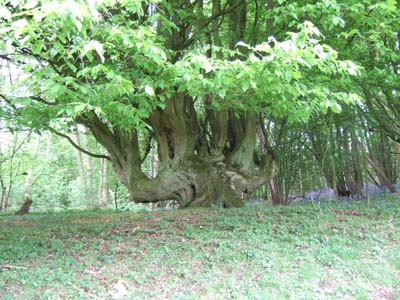Ancient Woodlands
 This ancient hornbeam tree was used to mark part of the boundary in Admiral Wood |
The UK’s equivalent of tropical rain forest is called Ancient Woodland. These are areas that have had continuous woodland cover since at least 1600. Before that date new woodland planting was rare, existing woods probably evolved naturally after the last Ice Age, about 10,000 years ago. |
|
Ancient woods in the UK are part of our heritage. They are beautiful all the year round and provide rich habitats for wildlife. They also contain many archaeological features which provide evidence of past land use as ancient woods were continuously managed by coppicing over the centuries. Coppicing is a traditional method of woodland management. Trees are cut down to a stump or stool to provide a crop then allowed to re-grow. This maintains trees at a juvenile stage, a regularly coppiced tree will rarely die of old age and as a consequence, many coppice stools in ancient woodlands are hundreds of years old. After coppicing several new shoots emerge from the stump, and, after a number of years the coppiced tree, now with several trunks, is ready to be harvested again. When it is cut depends on the use to which it is put. Quick growing birch for example, was coppiced for brushwood bundles every three or four years whereas slower growing ash and chestnut was coppiced over a much longer cycle. The range of different aged coppice compartments (or coups) provides a mosaic of vegetation structures across the wood which is of great benefit to biodiversity. Ancient woodland is also the home of many specialist species that only survive in these very special places. Once destroyed, ancient woodland habitat can never be replaced which is why it is vital that it is protected. Kent is fortunate to have the largest number of ancient woodlands in the UK. One, Gorham and Admiral Woods, an 85 acre ancient woodland at Bicknor is situated on a dry dipslope valley in the Kent Downs Area of Outstanding Natural Beauty. A prime site, it contains a huge variety of woodland types. Damp woodland grows on the floor of the valley, chalk woodland on its slopes and acid type woodland on higher ground. The woods contain 52 Ancient Woodland Indicator plants such as bluebells, wood anemones, herb paris and several orchids and over 400 species of fungus. (More information about the wood can be found on the Kent Landscape Information System: www.kent.gov.uk). But many of our ancient woodlands in the UK are under threat. Many are threatened by development such as quarries and roads and in the past decade over 100 have disappeared. A new charity, the Kent Woodland Employment Scheme, www.kwes.org.uk is now working to help end this destruction by setting up training schemes for ex-service personnel, young people and ex-offenders to train in coppicing and woodland management that will help to restore ancient woodlands in Kent. | |

